If you’ve ever heard the saying, ‘Don’t put all your eggs in one basket,’ you’ll appreciate the versatility of a galvanized stock tank vegetable garden. Imagine transforming a simple stock tank into a bountiful source of fresh produce right in your backyard.
In this guide you’ll learn how to optimize space, choose the right plants, and maintain a thriving garden – all within the confines of a sturdy metal stock tank. The possibilities are endless, and the benefits are certainly worth exploring further.
Stock Tank Gardens
- Durable and low-maintenance solution for thriving vegetable gardens.
- Selecting the right stock tank size and materials is important.
- Calculate costs accurately to create a cost-effective garden.
- Implement sustainable practices for a flourishing herb and vegetable garden.
Benefits of Galvanized Stock Tank Gardens
When considering the benefits of galvanized stock tank gardens, you’ll find a durable, low-maintenance solution that promotes excellent drainage and heat retention for thriving vegetable growth. These stock tank gardens, basically a raised bed made from a galvanized stock tank, offer the advantage of good drainage, vital for preventing waterlogged soil that can harm your plants.
By having drainage holes in the bottom of the tank, excess water is efficiently drained, ensuring your vegetables’ roots stay healthy and well-oxygenated. Additionally, the heat retention properties of galvanized stock tanks create a warm environment ideal for nurturing heat-loving plants like tomatoes and peppers.
To further enhance the growth of your vegetable garden, consider incorporating organic matter into the soil to provide essential nutrients for your plants. For efficient watering, installing a drip irrigation system can help maintain the best soil moisture levels, promoting healthy and vigorous vegetable growth. Lets have a look at all of these ideas and more now.
Choosing the Right Stock Tank Size
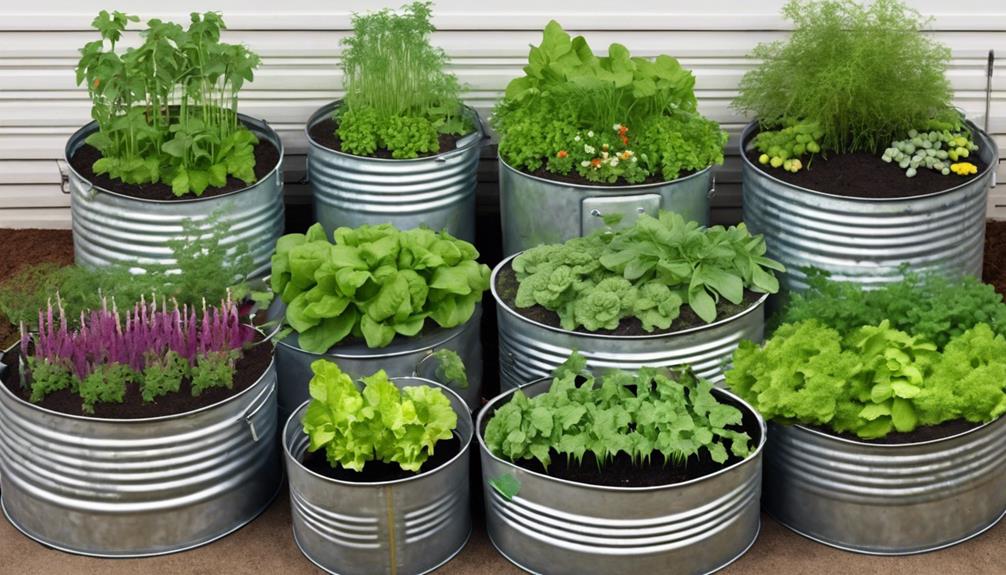
To select the ideal stock tank size for your vegetable garden, assess the available space and plant requirements to guarantee perfect growth conditions. When choosing the right stock tank size, consider the following:
- Plant Quantity: Determine the number of plants you plan to grow to select a stock tank size that can accommodate them adequately.
- Space Availability: Take into account the space where you intend to place the stock tank and choose a size that fits the area without overcrowding.
- Plant Size: Consider the mature size of the vegetables you intend to grow. Select a stock tank size that allows for proper plant spacing and growth to assure healthy development.
Essential Materials for Your Garden
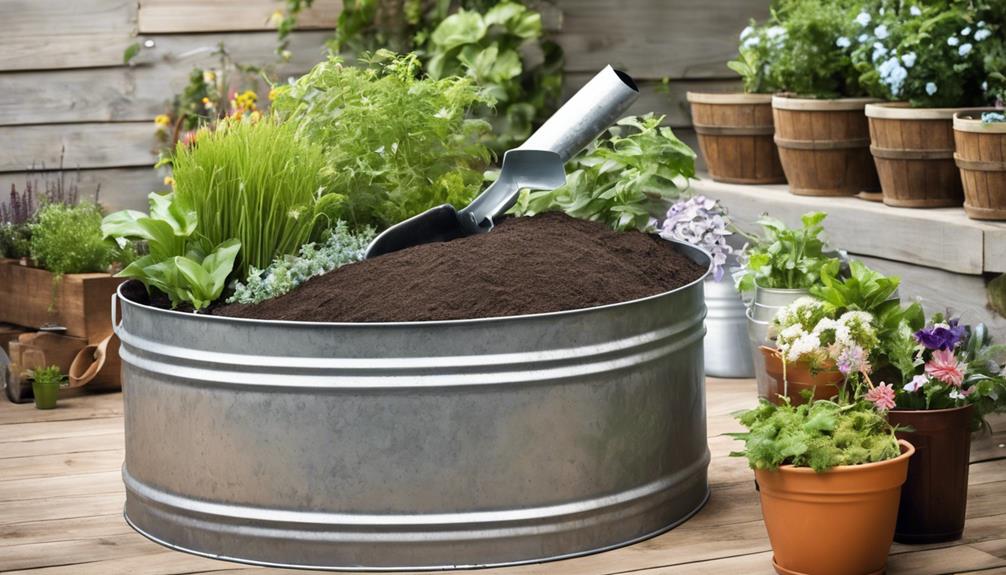
Evaluating the available space and plant requirements is important when determining the necessary materials for your galvanized stock tank vegetable garden.
Start with selecting the appropriate stock tanks. These tanks come in all different sizes and provide a durable and rust-resistant container for your vegetables, withstanding harsh weather conditions.
Utilize landscape fabric to control weeds and create a stable base for your stock tank garden.
Garden soil and compost are necessary materials for providing essential nutrients to your plants, ensuring healthy growth in your vegetable garden.
Additionally, incorporating mulch helps retain moisture, suppress weeds, and regulate soil temperature within the galvanized stock tank.
By combining these materials thoughtfully, you create an environment that fosters best growth for your vegetable garden. Its not difficult to establish a thriving galvanized stock tank vegetable garden that will yield bountiful and healthy produce.
Calculating Material Costs
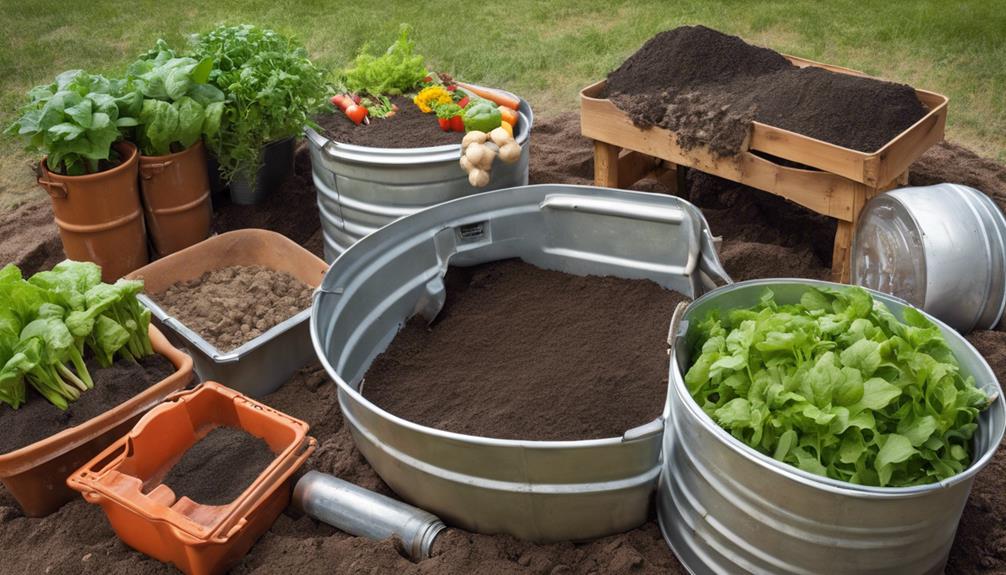
To accurately assess the costs of materials needed for your galvanized stock tank vegetable garden, break down the expenses for tanks, gravel, soil, mulch, and labor to create a detailed budget plan.
Understanding the cost of each component is important in making informed decisions and optimizing your budget for this project.
Here are three key points to think about while calculating material costs for your vegetable garden:
- Detailed Cost Breakdown: Analyze the expenses for each element such as the galvanized stock tanks, gravel, soil, mulch, and labor to get a complete overview of your budget requirements.
- Budget Optimization: By accurately estimating the costs of materials, you can plan effectively and make sure a budget-friendly approach to setting up your vegetable garden with stock tanks. Particularly if you plan to create several.
- Informed Decision-Making: Knowing the precise material costs empowers you to make informed choices, enabling you to create a cost-effective and productive vegetable garden using galvanized stock tanks.
Step-by-Step Guide to Building
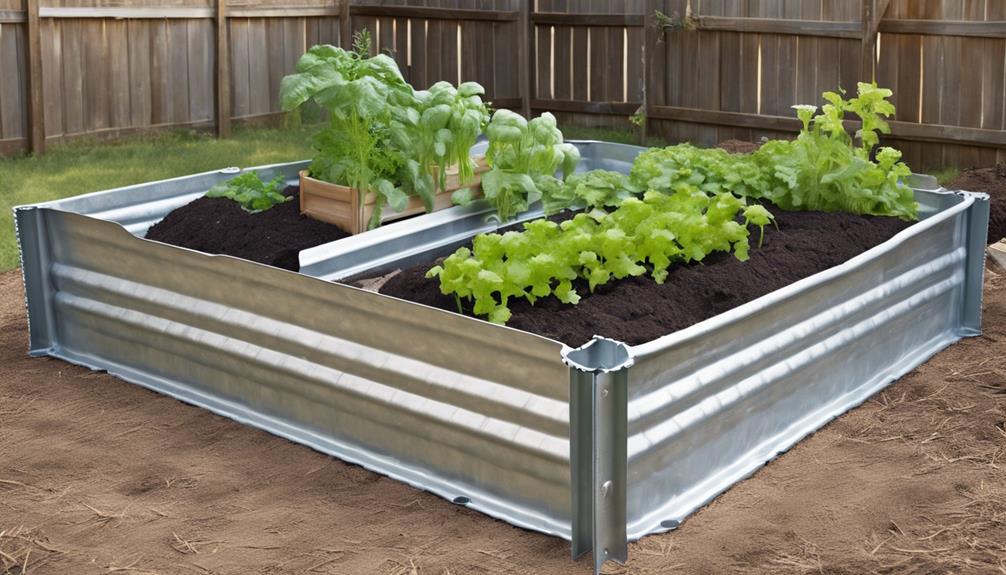
For efficient construction of your galvanized stock tank vegetable garden, begin by laying down landscape fabric as a weed barrier and to guarantee proper drainage.
This fabric will help in preventing weed growth while allowing water to drain effectively, creating a healthy environment for your plants. If you don’t have landscape fabric handy, you can also use old cardboard boxes as an alternative.
Next, add crushed limestone and large stones to form a stable foundation for the raised garden bed made from galvanized metal stock tanks. Make sure there are drainage holes in the tanks to prevent waterlogging. Add a layer of pea gravel to further improve drainage.
Optionally at this point you can add a decent layer of straw. The straw will break down overtime, slowly releasing nutrients for your plants.
Once this is done, mix compost and topsoil to fill the stock tanks, providing essential nutrients for your vegetable garden. Remember to remove the tank plugs (if there are any) to allow excess water to flow out, preventing any waterlogging issues.
This setup will create a prime environment for your plants to thrive, especially when coupled with a drip irrigation system for efficient watering.
Preparing the Beds for Planting
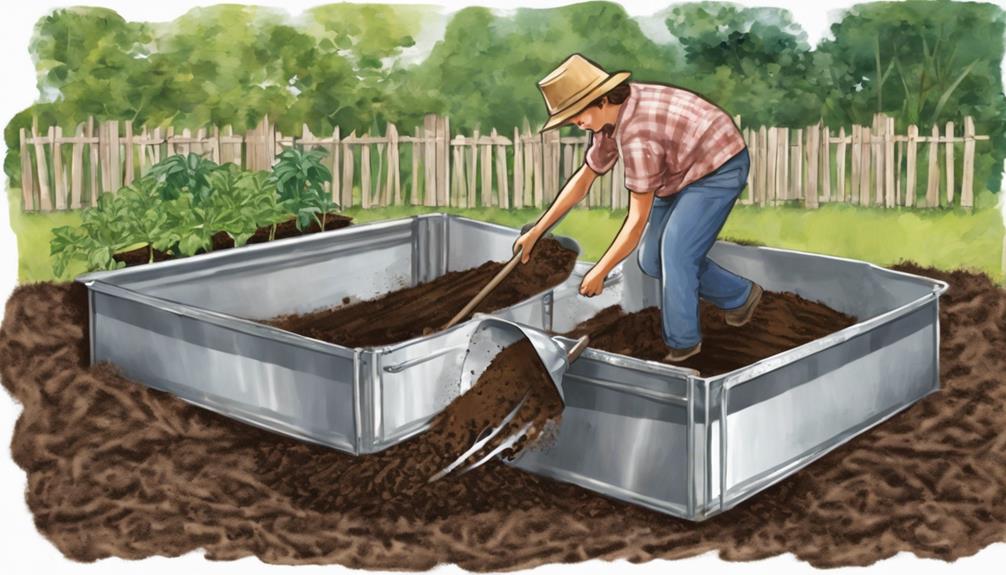
Consider incorporating a layer of nutrient-rich compost into your galvanized stock tank to prepare the beds thoroughly for planting. To make sure of the best growing conditions for your vegetable garden, follow these expert tips:
- Drill Drainage Holes: Proper water drainage is essential for the health of your plants, so make sure to drill adequate holes in the bottom of the stock tank.
- Use Landscape Fabric: Prevent soil erosion and maintain cleanliness by placing landscape fabric at the base of the tank before adding soil.
- Mix Compost and Topsoil: Create a nutrient-rich growing environment by combining compost and topsoil in the stock tank.
Selecting the Ideal Vegetables
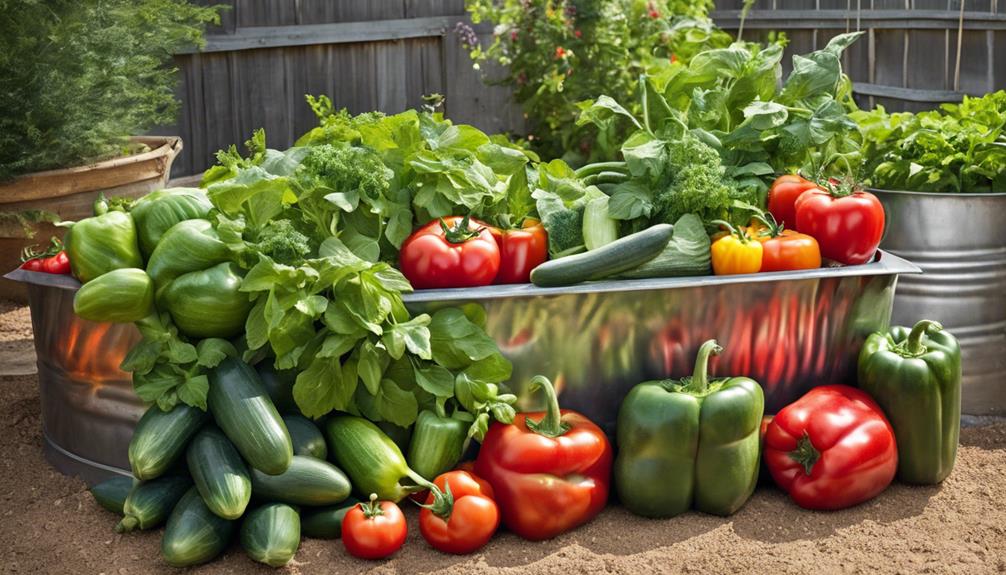
In preparing your galvanized stock tank vegetable garden, the first step is to carefully select vegetables that thrive in containers and can benefit from the unique properties of the metal planter.
Opt for heat-loving plants like tomatoes, peppers, zucchini, eggplants, and herbs that will flourish in the heat retention properties of the stock tank.
Choose vegetables with shallow root systems such as strawberries, which are well-suited for the depth of a stock tank planter. Guarantee good drainage by selecting plants that require it, preventing waterlogging in the metal container.
Additionally, make sure you have ample space for the root systems to grow unhindered.
Tips for Flower Seeds and Tomatoes
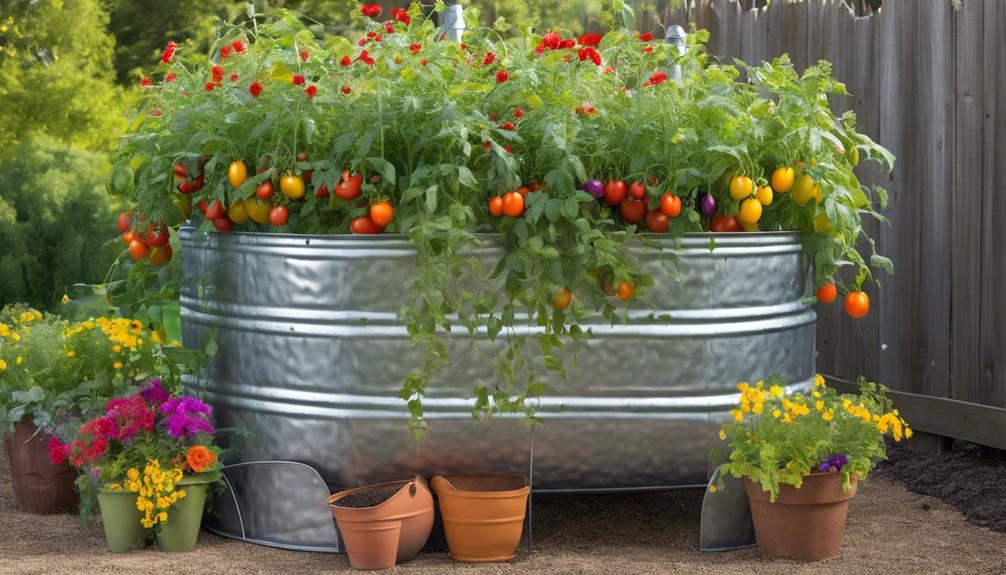
Planting flower seeds in your galvanized stock tank will add a beautiful touch to your garden while supporting the healthy growth of your tomato plants with wooden cages.
To guarantee a successful garden in limited space, consider the following tips:
- Choose Long-lasting Flower Seeds: Select flower seeds that can bloom until late fall to maintain a colorful and vibrant garden throughout the seasons.
- Utilize Wooden Cages for Tomatoes: Use wooden cages to provide support for your tomato plants, promoting healthy growth and preventing damage.
- Organic Fertilizer for Healthy Growth: Opt for organic fertilizer to nourish your flower seeds and tomato plants, encouraging robust growth and blooming in your stock tank vegetable garden.
Growing Herbs in Stock Tanks
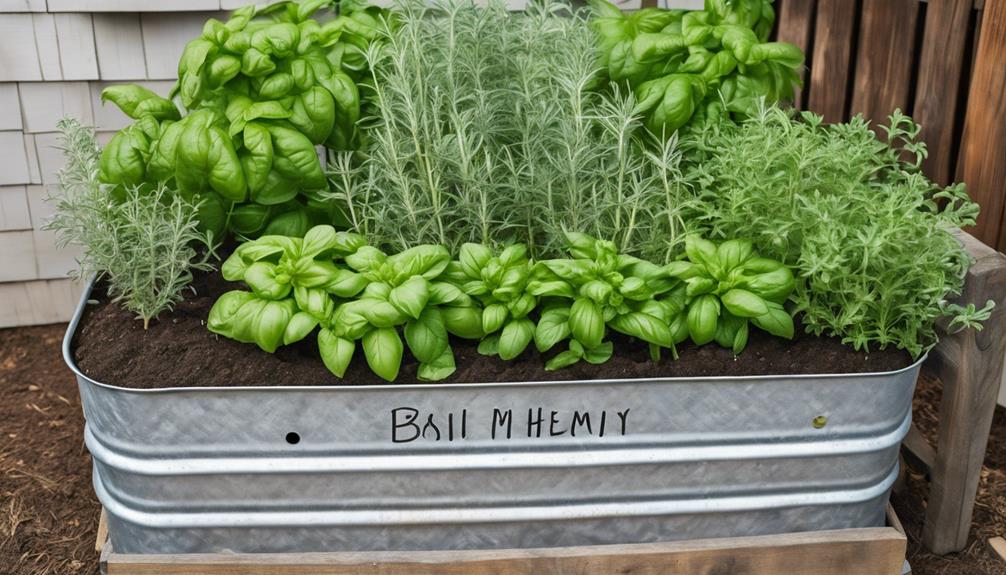
Herbs such as basil, thyme, and mint flourish remarkably in stock tanks due to their shallow root systems. When creating an herb garden in stock tanks, it’s essential to guarantee adequate drainage and sunlight for best growth.
To support the herbs’ development, plant them in separate stock tanks to prevent overcrowding and competition for nutrients. Utilize a well-draining soil mix enriched with compost to provide the necessary nutrients for the herbs to thrive in the stock tank environment.
Regularly harvesting the herbs is key to promoting new growth and maintaining plant health in the stock tanks. By pruning the herbs often, you encourage bushier and healthier plants. This practice also prevents the herbs from becoming leggy or woody.
With proper care and attention to the specific needs of each herb variety, you can create a flourishing herb garden in your stock tank, ensuring excellent growth and a bountiful harvest.
Maintaining a Healthy Harvest
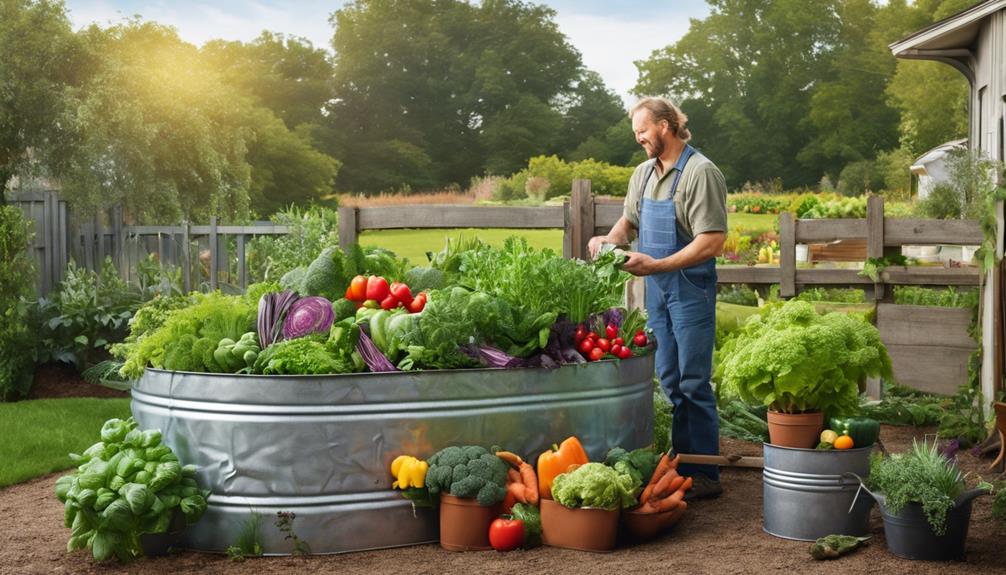
To maintain a healthy harvest in your galvanized stock tank vegetable garden, monitoring of plant health and timely crop harvesting are important practices for ensuring a bountiful yield.
- Implement Proper Watering Techniques: Guarantee plants receive adequate hydration for best growth and productivity.
- Check for Pests and Diseases Regularly: Address any issues promptly to prevent damage to your vegetable garden.
- Consider Organic Fertilizers: Provide essential nutrients for your plants to promote healthy and vigorous growth.
In addition to these practices, rotating crops in your stock tank vegetable garden from season to season is a good idea to prevent soil depletion and maintain a balanced ecosystem for sustainable gardening success. By staying proactive and attentive to the needs of your plants, you can cultivate a thriving vegetable garden in your galvanized stock tank.
Remember that a healthy garden leads to a bountiful harvest, fulfilling your gardening aspirations and providing you with fresh produce throughout the growing season.
Frequently Asked Questions
Can You Grow Vegetables in a Galvanized Stock Tank?
Yes, vegetables can thrive in a galvanized stock tank.
They’re excellent for container gardening due to their depth, aiding robust root systems. Various vegetables like tomatoes and peppers flourish in this setup. Good drainage prevents waterlogging, essential for healthy roots.
Regular fertilizer application promotes growth. Sunlight exposure is important for a successful harvest schedule. Galvanized stock tanks act as a protective shield against ground pests, ensuring a bountiful vegetable variety.
Is It Safe to Grow Vegetables in Galvanized Steel Containers?
When using galvanized containers for your vegetable garden, concerns arise due to potential zinc leaching. This metal toxicity can impact plant health if consumed excessively.
To secure food safety, consider using a food-grade sealant or a barrier lining. Opt for less zinc-sensitive plants and monitor for rust prevention.
Can You Use a Galvanized Water Trough for a Raised Garden Bed?
You can certainly use a galvanized water trough for a raised garden bed. They excel in providing proper water drainage and offer control over soil composition.
They also assist in best plant spacing, guarantee adequate sunlight exposure, and aid in weed prevention. Additionally, they help with pest control, allow for precise fertilizer application, and simplify harvesting techniques.
With these advantages, a galvanized water trough makes a reliable and efficient choice for your vegetable garden needs.
What Do You Put in the Bottom of a Stock Tank Planter?
To guarantee maximum growth in your stock tank planter, start with proper soil preparation and drainage solutions. Layer gravel and straw at the base, then add organic soil.
Fill the planter to at least 3/4 depth for robust root development. Consider mulching with straw to retain moisture and reduce watering frequency.
Space plants appropriately, and provide necessary nutrients for healthy growth.
Stock Tank Success
To sum up, creating a galvanized stock tank vegetable garden can be a rewarding and productive way to grow your own fresh produce. By selecting the right size tank and using proper materials you can enjoy a bountiful harvest of vegetables, herbs, and flowers.
Remember to maintain your garden regularly to make certain healthy plant growth and maximize your garden’s potential. Happy gardening!
